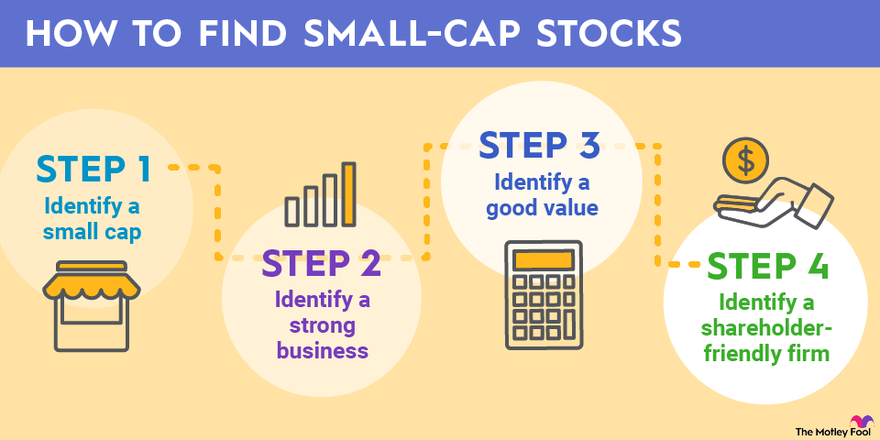There's no more important question facing investors than how to find great stocks. Just one stock can make a difference of tens or even hundreds of thousands of dollars, but finding tomorrow's big winners isn't easy.

What are they?
What are small-cap stocks?
If you're looking for potentially life-changing returns, investing in small-cap stocks is a good start. These stocks are from companies smaller than those of the blue chip stocks that make up the Dow Jones Industrial Average (DJINDICES:^DJI) and much of the S&P 500 (SNPINDEX:^GSPC).
However, they tend to offer the most growth potential. That makes small caps among the most exciting segments in the stock market today. While they are definitely volatile, you won't find any other slice of the market that matches their potential upside.
Our four-step guide will teach you the ins and outs of finding and investing in small-cap stocks.
Step 1
Step 1: Identify a small cap
When looking for great small caps, the first thing you need to do is start with small companies. For our purposes, that means any company with a market capitalization (market cap) between $300 million and $2 billion.
According to the stock screener Finviz.com, 1,599 companies valued between $300 million and $2 billion are trading on the major U.S. exchanges. That's too many to work with, so we will need additional criteria.
Step 2
Step 2: Identify a strong business
There are several ways to identify a strong business, but what makes small-cap stocks appealing to most investors is their growth potential. Investors should focus their search efforts on finding companies that could deliver explosive growth or have the potential to be the next Amazon (AMZN 0.73%) or Netflix (NFLX 0.78%).
Here are a number of metrics to help determine whether a small-cap stock could be a big winner.
Revenue growth
Of all the ways to measure a business, revenue growth is probably the most important for finding big potential winners. Generally, investors should look for a company with at least 20% revenue growth, a level that often demonstrates disruptive potential, and the ability to sustain that growth.
If a company's revenue growth is decelerating, that's a sign that either its business is maturing or the industry was based on a fad. Some recent examples of the latter phenomenon are Groupon (GRPN 0.58%) and Blue Apron, which were acquired by Wonder Group in 2023 for $103 million.
Past price appreciation
Since investors generally respond to strong businesses by sending the stock price up, past stock-price appreciation is a good sign of a company that has what it takes to outperform over the long term. Alternatively, stocks that have languished for several years or mirrored the market are less likely to deliver monster growth.
While underlying business performance is ultimately more important than the movement in the stock price, past price appreciation is an easy quality to look for and recognize.
Total addressable market
It's also important to consider how big a company can become. Often, companies cite their total addressable market (TAM) -- which could be in the tens of billions, hundreds of billions, or even trillions -- to show how big their growth opportunity is. Some categories, like e-commerce, tend to have huge TAMs because the companies are disrupting physical retail, a multitrillion-dollar industry.
Other businesses are more focused and will have less room to grow. A large TAM alone isn't evidence of a strong business, but combined with other metrics, such as revenue growth, it can point to a potential juggernaut. Additionally, it's helpful when a company can extend to adjacent businesses, expanding its addressable market.
Profit potential
Many small-cap stocks aren't profitable. Often, these are young companies still growing rapidly and investing in the future. However, even if a given stock isn't in the black, it's important to consider its ability to turn a profit. This could come from its business model, competitive advantages, or a valuable asset. Similarly, you'll want to examine the company's margins to see whether they are moving toward profitability.
If the company isn't profitable according to generally accepted accounting principles (GAAP), it's also worth looking at metrics like non-GAAP earnings; earnings before interest, taxes, depreciation, and amortization (EBITDA); and free cash flow. Alternatively, if a stock is profitable, earnings per share (EPS) growth is the best metric to follow.
Generally Accepted Accounting Principles (GAAP)
Step 3
Step 3: Identify a good value
Again, there are many ways to measure the valuation of a small-cap stock, but the two most common are the price-to-earnings (P/E) ratio and the price-to-sales (P/S) ratio. For solidly profitable stocks, the P/E ratio is generally the most important ratio to use.
It's helpful to look at it within the context of the company's overall growth since high-growth companies tend to have higher P/E ratios. You'll also want to use the P/E ratio to compare companies within the same industry. Across the overall market, the metric can vary widely, from single-digit P/Es for mature automakers to triple-digit ratios for high-growth tech stocks.
Keep in mind that the S&P 500's P/E has hovered around 25 in recent years, representing what most investors are paying for a mature stock. The P/E of the most closely tracked small-cap index, the Russell 2000, is usually higher because so many companies in it are losing money.
The P/S ratio offers a better guideline for unprofitable stocks. The metric works similarly to the P/E but uses sales in place of earnings since revenue is generally the best measurement of the size of unprofitable companies.
P/S ratios vary widely among companies. Like P/Es, they should be used within the context of growth and industry peers. Some software-as-a-service (SaaS) stocks have seen their P/S ratios jump to over 50, implying tremendous future growth from these stocks. A P/S of 10 or higher would generally be considered expensive in other sectors.
With small-cap stocks, it's also worth considering analyst coverage. Some of these stocks may have only a handful of Wall Street analysts following them, leading to minimal media coverage. These stocks are more likely than others to be undervalued simply because not as many investors are aware of them or the opportunity they may present.
Wall Street
It's important to remember that a low P/E ratio or P/S ratio alone isn't a good reason to buy a stock. You must first consider the quality of the business before looking at the valuation.
Step 4
Step 4: Identify a shareholder-friendly firm
This can be a difficult quality to screen for, but two proxies you can use are insider ownership and whether a company pays a dividend. If a significant percentage of a small-cap stock is owned by its managers and it pays a dividend to shareholders, the company's interests are likely aligned with those of outside investors. However, keep in mind that it's rare for a growth stock to pay a dividend.
In addition to shareholder-friendly policies, you'll want to consider the leadership more generally. To assess a company's management, it's a good idea to look at employee reviews on Glassdoor, how long management has been in their current roles, whether the company is led by its founder, and how it communicates with investors on earnings calls and quarterly releases.
Ultimately, leadership is the most important qualitative aspect of a business since leaders are responsible for executing, meeting, and hopefully exceeding company goals.
Related investing topics
Put it all together
It's not easy to find the next 100-bagger, of course, but you're looking in the right place if you're considering small-cap stocks. By investing in small caps, individual investors can give themselves an advantage over institutional investors, who tend to avoid stocks of this size because they aren't big enough for them to make significant investments that would move the needle on their portfolios.
The tools above should give you a good start in your search, and using a screener is always a good idea since most of these companies won't be household names. Narrowing your search to a few small-cap stocks with the greatest potential for generating high returns will increase your chances of owning the next Amazon or Netflix.
FAQ
How to find small-cap stocks: FAQ
How do you find small-cap shares?
To identify a company with a market cap between $300 million and $2 billion, you can use a screening tool, such as Finviz.com, or research companies you're interested in on a financial news portal, such as Yahoo! Finance, to see whether they meet that criteria.
Are small-cap stocks a good investment?
Small-cap stocks can be a good investment. Historically, they are more volatile than their large-cap peers, but because they are smaller, they also offer more upside potential.
Where can I invest in small-cap stocks?
If you're interested in investing in small-cap stocks, the easiest way to do so is through an exchange-traded fund (ETF). You can choose one that tracks a small-cap index, like the Russell 2000, or one that follows a more specific group of small-cap stocks.











